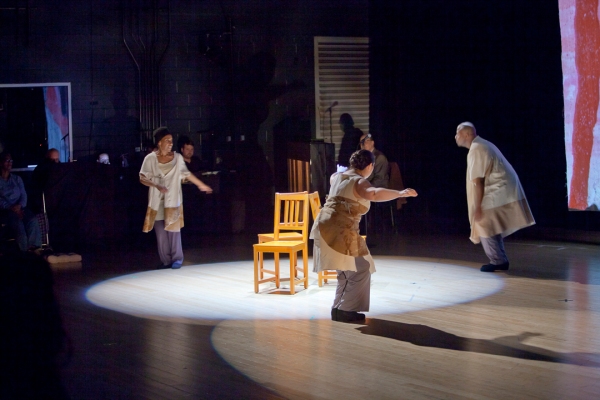
Germaine Ingram, Corrine Karon and Khalil Munir reimagine a ringshout during “Where Heaven’s Dew Divides.” (Photo: Kevin Monko)
The break is an unexpected, uncontrollable space where an insistent beat is interrupted by a flash of contradictory rhythmic ideas…it contains both the tie to a ubiquitous rhythmic flow and the potential for anarchy and disruption.”
— Thomas A. DeFrantz
Adrienne Abdus-Salaam:
Rhythm was a continuum. Rhythm was a through-line – for everybody, for everything, continuosly. And each of us approach rhythm from a different standpoint. I come from the 8-count, you know, being a dancer. But I also having the African dance influence: so this whole idea of polyrhythm, and being in the pocket but not necessarily being on the one, the downbeat. And hearing a different rhythm than someone else may be hearing, but seeing how it all works together. It was a conversation, and each of us approached it and had very different ideas about it. But all the ideas were able to come into the pot and work together, and that was the great thing about the experience. Nobody was the expert. There were times when I might not understand what the heck was going on right now, ‘but what I do understand is this is what I’m doing, so I’m gonna hold onto this. I’m gonna trust the environment, and trust the process that it’s all gonna come together.’
There were feelings of being a little vulnerable sometimes, because you may have established your own ‘rhythm’ – whatever you were hearing, whatever you were feeling – and then layering is happening, because you’re bringing other people into the fold. It’s not a solo; it’s an ensemble project. When those other parts come in, it may be difficult for you to hold onto what you did. And then you begin to question yourself: ‘Is this still working?’ You know, ‘Is this still true? ‘Cause it was when I was by myself. Is it now?’
And I think part of trusting Germaine and Leah, and part of trusting the other ensemble members, is knowing that we’re all there, it’s a collaborative experience, we’re all supporting each other, and, you know, it’ll be what it’ll be. There is nothing wrong or bad, and when I allowed myself to operate like that, it was very freeing, and a lot of great stuff came from it. What I’ve gotten from that experience is you just have to step back and just be, you know.”
Germaine Ingram describes the very first meeeting of the professional learning community. Full rhythmic experimentation and subsequent conversation about the centrality of rhythm in each artists’ practice, the session lead unintended collaborations with jazz pianist and composer, Dave Burrell:
When I submitted the application for Dance Advance, Dave Burrell wasn’t one of the artists that I included in that plan. However, in the very first meeting of the learning community, we had this really rich experience related to rhythm. Leah and I shared this score that we had worked on related to a really potent quotation that Thomas DeFrantz included in an essay on the break. And so Leah and I shared that score with the learning community and invited them to come into that score. So that exercise must’ve gone on for a half-hour or so. It grew into this really rich discussion about people’s relationship to rhythm. Some people are saying, “I don’t use rhythm in my work.” And of course the tap people saying, “Yeah, well that’s the stock and trade in my work.” And some people saying, you know, “Rhythm really scares me.” So that gave me the idea that working with rhythm would be a really good way to jumpstart this process. It’s a conversation that grew spontaneously out of our first session together, and it’s certainly a question that has resonance and importance for a host of issues and questions that we were dealing with as a learning community.
For the past four years, jazz piantist and composer, Dave Burrell has been Artist-in-Residence at the Rosenbach Museum interpretting historical materials from the museums collections. In the video below, Dave discusses his use of rhythm to create meaning in his historical interpretations.
Khalil Munir shares his thoughts about the presence of rhythm in all aspects of life:
Well, not to be philosophical, but rhythm is life. Rhythm is all around you, all the time. In this interview right now, I can hear birds outside, I hear a street car, I hear so many things that surround me right now that just go along with everyday life. And as an improvisational tap dancer, that’s something I’m pretty aware of at all times. What’s going on around me rhythmically? I hear a lot of things, that I pull from, as an artist.
In terms of the whole life piece: your life is full of ups, downs, stops, breaks, progressions. It’s full of all those things. And how you dance along with it is really what you’re preparing yourself for, and moving forward in your rhythmic life…
I started dancing at 16. And I’m a self-taught tap dancer, so I really didn’t know any technical terms, and I still really don’t. But I do know what I feel, rhythmically. And when I put my shoes on, I get an opportunity to really express myself through rhythm. Germaine gets on me, too, about my time signature and me counting. It’s like, I don’t count, I don’t really follow the guidelines of time signatures and things of that nature. I really just dance to what I feel in my heart. And I think that’s another evolution of my dancing to learn those things. And I’m going to do that. And that was one of the reasons why I really wanted to work with Germaine, was to try and pick up some of the things that she’s doing.
